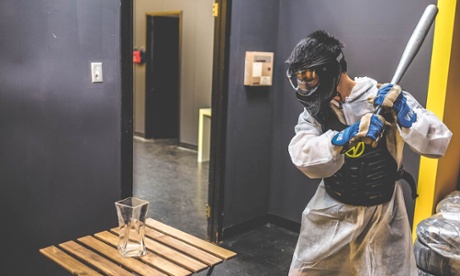
Teeing off in the late afternoon, my wife surveys her target, winds up to swing and, with a sound like a thunderclap, drives the club into a garden gnome’s skull.
We are at the new Rage Room at Battle Sports in Toronto, where in exchange for $20 and a sense of composure, one may shatter, smash, or otherwise dismantle a variety of household objects.
It’s a sort of therapeutic exercise: destruction as a bid to relieve tension. And it works.
Drubbing the splintered gnome with tiny blows, my wife heaves contentedly, stopping only when the shards have been pummeled to dust. “Whew,” she sighs. “What can I smash next?”
While she sets to work abusing an alarm clock radio, I take a moment to grill Timothy Cheung, one of the room’s co-founders, about the genesis of this amusement.
A similar service, Cheung tells me, sprang up a number of years ago in Serbia, where it became something of a controversial phenomenon. Were Cheung and his partners confident that a Serbian sensation would translate here? “Toronto is such a high-strung city,” he says, grinning. “We thought it could stand to let off a little steam.” After persuading a skeptical insurance company that their plan was less outrageous than it seemed, Battle Sports was swiftly in business, erected in a remote industrial park in the city’s north end.
My wife now sufficiently pacified, it is my turn to enter the Rage Room. I sign a liability waiver so long it could be for Jurassic Park, and eagerly gear up. Fitted with thick gardening gloves and a paintball mask, and stepping awkwardly into white full-body polypropylene coveralls, I look like a very tall Oompa Loompa, as if instead of demolishing furniture I was about to sing a cautionary song.
Singing is, in fact, a possibility. Battle Sports provides a bluetooth speaker for the room, and I pipe in some music: Still by the Geto Boys, the song the characters listen to while smashing a printer in Office Space (it’s a scene Cheung tells me many of his customers like to recreate).
I opt to begin with the basic package: 30 minutes alone with a weapon of my choosing and five ceramic dinner plates (acquired from yard sales and thrift stores, lest one worry unduly about waste).
Free at last to satisfy my well-known animosity toward dishware, I find I am nevertheless unable to summon any deep reserves of anger. Cheung says that’s normal. He even encourages customers to make the most of their time by collecting their thoughts and “projecting their hatred and rage onto the breakable objects”.
It helps that getting to the Battle Sports facility is a two-hour journey by subway and bus: the protracted travel ensures that one arrives already aggrieved and seething, wishing maximum violence on commuters who hog seats or wear oversized backpacks. My hostile energies concentrated, I lay waste to the inanimate objects, tossing plates into the air and firing them off like dinnerware grand slams.
Having exhausted my supply of complimentary prey, I turn to the à la carte Smash Menu: here one can select from a battery of appealingly destructible gimmicks, from wine glasses to vases, tea cups to decanters.
I go with a sturdy wooden chair. I heave the thing up and place it delicately on the Rage Room’s central stand – an “indestructible block of mysterious material” that’s actually composed of super-compressed cloves. Eyes fixed, jaw clenched, I raise the bat above my head, thinking angry thoughts, and with all the force I can muster I drop it like a sledgehammer. A chip the size of a thumbtack is loosed from the wood. The chair flops embarrassingly to the ground.
Much to my surprise, I find myself, while thwacking away, in the throes of a genuine thrill: adrenaline has a way of taking over amid even simulated violence, which, despite no particular rage lingering in me, does feel rather therapeutic.
Cheung has a theory about that. “You’re told all your life not to break things,” he says. “The Rage Room goes against it. It can’t help but be cathartic.”

